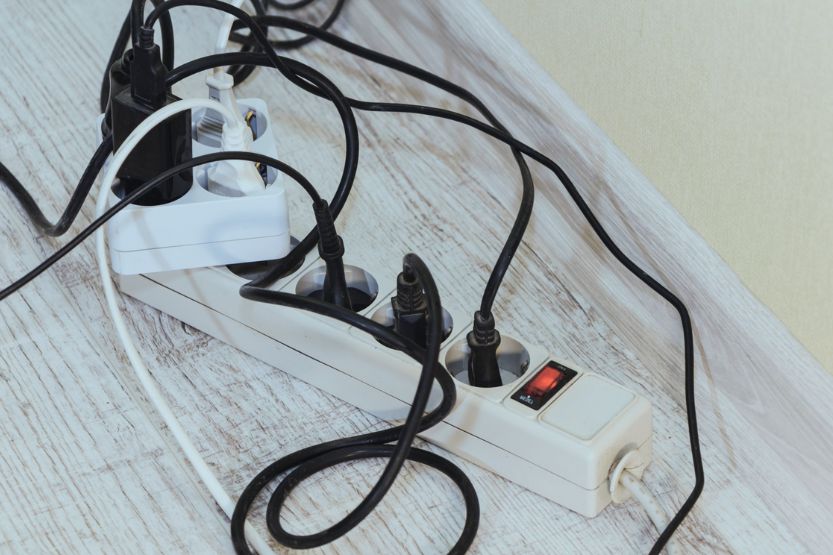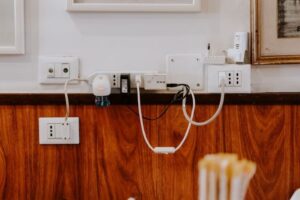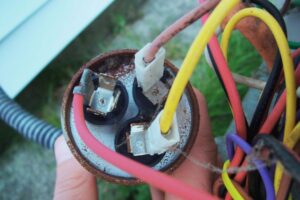You may need a surge protector if you have many electrical gadgets connected to just one power strip. What if one surge protector is not enough for your gadgets? Can you plug a surge protector into a surge protector?
It’s dangerous to plug one surge protector into another. You are facing certain risks if you do so. There is a maximum load that these electrical devices can take. You must keep the surge protector close to the convenience outlet, so you won’t accidentally trip over it.
The reason why you can’t plug a surge protector into another surge protector is that it can damage any electrical device that is at the end of the chain of connection. Your best option is to plug a normal power strip into the convenience outlet on the wall and then plug the two surge protectors into that.
Read on to learn more about surge protectors, what they are, and if you can plug a surge protector into another surge protector.
Can You Plug a Surge Protector Into a Surge Protector?

Plugging a Surge Protector Into Another Surge Protector Entails Certain Risks
You need to know what not to plug into a surge protector. Do not plug a surge protector into another surge protector because that entails certain risks. These electrical devices can only handle certain maximum loads that you can’t just abuse.
Keep the Surge Protector Close to the Outlet
In addition, you have to keep the surge protector close to the convenience outlet to prevent people from accidentally tripping it over. If you plug a surge protector into another surge protector, you can damage the electrical devices at the end of the chain.
Safe to Plug a Surge Protector Into a Wall Outlet
Your best option is to plug a standard power strip into the outlet on the wall. Then plug surge protectors into it.
So, it’s safe to plug a surge protector into a power strip but not safe to plug it into another surge protector. You can use a surge protector with a built-in power strip if you want the best results. You can then connect the power strip to the surge protector.
In addition, some surge protectors don’t come with instructions on how to use them. So, people are unaware that there is a right and wrong way of using them. If you piggyback a surge protector into another, you create an electrical hazard.
What Is the Function of Surge Protectors
Reduce Power Surges Caused by Lightning Strikes and More
The function of surge protectors is to reduce power surges caused by lightning strikes, electrical storms, and similar occurrences.
Surges Can Damage Electronic Devices
Power surges can damage electronic devices and household appliances connected to the wall outlet. It’s simply a wall outlet equipped with surge protection.
Surge Protector Rating
There are ratings indicated on every surge protector. It shows their capacity to withstand different types of power surges. The ones with higher ratings are the best at protecting against power surges.
You need to check the voltage rating of the surge protector to be sure it’s what you need. Just remember, those with lower ratings offer less protection.
While power surges are dangerous to your electrical devices and appliances, you don’t need to worry about them all the time.
Enough to Use the Best Outlets and Surge Protector
Don’t be like some people who install one surge protector for every outlet in their house. It is enough to use the best outlets and surge protector you need.
Consult an Electrical Contractor
You can consult an electrical contractor about the best surge protector and how many of them you need for your electrical requirements. But be aware that not all surge protectors are the same. And they don’t last forever, either.
Common Surge Protectors Have a Minimum Joule Rating of 200 to 400 Joules
There are different types of surge protectors for different kinds of applications. The most commonly available surge protector has a joule rating of a minimum of 200 to 400 joules.
Use a 1000-Joule Surge Protector If You Have Delicate Devices
However, if you are using delicate electrical devices such as computers, laptops, and high-end AVR systems, the safest surge protector you can use should have a minimum of 1,000 joules.
If you want maximum protection for your sensitive electrical gadgets, you need a surge protector rated at least 2,000 joules or more.
Surge Protectors Have a Limited Service Life
Surge protectors also don’t last forever. They all have a useable lifetime. So, if you have used your surge protector for many years, you may need to consider replacing it soon.
Is Your Surge Protector Adequate?

Use a Surge Protector That Is More Than Adequate for the Demand
To protect your electrical devices and appliances, you should be using a surge protector that is more than adequate for your demand. You can know if the surge protector you are using is sufficient enough by observing the following:
- Check the specs of your surge protector
- Read reviews about the surge protector you are using
Almost 20% of All Electrical Failures and Fires Are Associated with Surging Protectors
According to a report published by the U.S. Office of Compliance, almost 20% of all electrical failures and fires are associated with surging protectors due to connecting them in daisy chains. So many people don’t know they shouldn’t plug them into one another.
Overloaded Outlet Due to Interconnected Surge Protectors
If you interconnect surge protectors with several electrical devices plugged into them, you cannot hook them all up into one wall outlet. This will overburden the wall outlet more than the electricity demands that it can take.
What happens is that more electrical current will run through the electrical devices than what is safe. This can cause an overload to the wall outlet, which can eventually trip the circuit breaker. If that does not happen, an electrical fire could start.
Risk of Fire or Failure When Power Surges Occur
Surge protectors in daisy chains overload their technology. This situation puts your electrical system at risk when power surges occur. If you are forced to use a power strip, do so only as a temporary solution and not as a habitual thing.
Again, can you plug a surge protector into a surge protector? Do not plug one surge protector into another. This can cause dangerous electrical issues.
What Happens If You Daisy Chain Surge Protectors?
Electricity Will Flow from the First Surge Protector to the Next
If you connect one surge protector to another, you join them in a series. This means electricity flows from the first surge protector to the next surge protector.
Some electricians do this to provide redundancy; if the first surge protector fails, the other protector will take up the chore.
Connecting Surge Protectors Does Not Increase the Ability to Absorb High Power Surges
Connecting surge protectors in series do not give you a more remarkable ability to absorb higher levels of power surges. Surge protectors come with different voltage levels.
Void Warranties
Some observers believe that you can tamper with the protection capability of surge protectors by daisy-chaining them. But that can void their warranties.
You are advised not to cascade one surge protector into another. Doing so will likely overload the power strip, the outlet, the electrical circuit, or the extension cord. Overloading an electrical circuit opens the risk of an electrical fire.
Use a Power Strip with More Outlets If You Need to Plug in Several Devices
To be safe, use a power strip with more outlets if you need to plug in several devices simultaneously. The power strip should also be rated as heavy duty. An alternative is to plug another power strip into a separate wall outlet powered by a separate circuit breaker.
Can you plug a surge protector into an extension cord?
For computer systems that don’t have any backup, overloading your power strips and surge protectors can destroy your computer and all the data inside it, and maybe even your office if an electrical fire happens.
Surge Protection: Do’s and Don’ts
You are probably using surge protection foremost as protection for your electronic devices. It is also required to get the right insurance policy against power surges. As such, you need to know the dos and don’ts of surge protectors:
The Do’s
1. Plan
It is wiser to overestimate the number of electrical outlets that you may need. This will make it easy for you to add several electrical devices later.
2. Always Check Your Connections
Aside from the wall outlets, you may also need a USB, coaxial points, and networking.
3. Invest in a Surge Protector with Higher Joules Rating
Surge protectors are differentiated by their joules rating. It is better to buy a surge protector with a higher joules rating to absorb unforeseen higher power surges and not fail. The higher the joules rating, the better is the surge protector.
4. Check the Sizes of Your Plugs
Buy a surge protector with widely spaced outlets to plug in even oversized plugs.
5. Check the Safety Features
Surge protectors offer fireproof and fail-safe technology. Buy these types so you can have additional protection against power surges.
6. Choose Green Technology
Buy a surge protector that is energy efficient. Surge protectors come with smart outlets, which reduce the power supply to the devices when they are not in use.
7. Check the Small Print
Before buying a surge protector, ensure it comes with a warranty and is also UL listed.
The Don’ts
1. Daisy Chain
Never plug surge protectors one into another. This is called daisy-chaining, which is very dangerous for your electrical devices and appliances. It can trigger the start of an electrical fire which can burn your office or your house.
2. Don’t Get Confused
A surge protector looks similar to a power strip. They are very different from each other, so don’t confuse one with the other.
3. Don’t Overload
Ensure that all the devices you plug into one surge protector have a total electricity demand lower than their capacity or rating. Usually, surge protectors are classified with their wattage ratings.
4. Don’t Use a Surge Protector for Certain Electrical Devices
Never use a surge protector for such devices as microwave ovens and electrical heaters.
5. Don’t Get Frustrated
If, at first, you have difficulty using the surge protector, don’t get frustrated. Just read its instruction manual. Also, by repeated use, you will get the hang of it.
6. Don’t Use It in Damp Areas
If a surge protector gets wet, it will be more of a hazard than a safety tool. So, please don’t use it in areas with high humidity that are usually damp.
A Word About Daisy Chaining

Perhaps you’ve heard many warnings about the dangers of daisy-chaining power strips. If it is not a safe practice for power strips, then it is more dangerous with surge protectors.
Certain power strips also come with surge protection features. Some assume they can daisy chain them without problems, just like ordinary power strips.
Now, you wouldn’t have a problem plugging in things like a cell phone charger, a lamp, or an alarm clock.
But you can’t do that for sensitive electrical devices such as computers, audio-visual components, and other expensive electrical appliances. At least you should check its power rating to avoid overloading it. Even then, the safest practice is not to practice daisy-chaining surge protectors.
How Long Can a Surge Protector Last?
Surge protectors don’t last forever. So, how long can you use a surge protector? Some surge protectors come with LED lights. The LED light tells you if the surge protector can no longer do its work.
So, if the LED light on your surge protector goes dead, it can no longer protect the electrical devices or appliances plugged into it. It’s time for you to replace it with a new one.
Surge protectors come with built-in automatic shutdown, connected equipment guarantees, and lifetime warranties. If you can find one of these, then buy it.
What Is the Difference Between Surge Protector and a Power Strip
A surge protector is very different from a power strip. Their functions are not the same. You need to use a power strip if you want a constant flow of electricity to several electrical devices simultaneously. You can power up or turn off power to several electrical devices with a power strip.
It’s different from the surge protector. While it looks similar to a power strip, its function is not the same. A surge protector’s function is to protect electrical devices from a power surge or spike.
Frequently Asked Questions
To enlighten you more about surge protectors, the safe and proper way to use them, and their differences with power strips, you have to read the answers to the most often asked questions about them:
Can I Plug a Surge Protector Into Another Surge Protector?
Plugging a surge protector into another surge protector is a dangerous practice, so you are advised not to do it. There are certain risks involved in this practice.
You can overload the surge protector, which can trigger an electrical fire, and perhaps damage the appliances connected to it. It may even lead to your entire house catching fire.
Can You Plug a Power Strip Into a Surge Protector?
Yes, it is entirely safe to do this. However, daisy-chaining power strips into a surge protector are not advisable. It may overload the surge protector.
Why Can’t I Plug a Surge Protector Into Another Surge Protector?
You can do this because it can damage the electrical device or electrical appliance at the end of the chain. Your best choice is to plug a standard power strip into the wall outlet and then plug the surge protector into it.
What Appliances Should I Not Plug Into a Surge Protector?
Some appliances you can’t plug into a surge protector include electric heaters and microwave ovens.
How Can I Know If My Surge Protector Needs to Be Replaced?
If you have a surge protector with an LED light that is turned on, that indicates that it is still working fine. This means you can still use the surge protector. However, if this LED light goes dim or entirely goes dead, you need to buy a new one.
What’s the Difference Between a Surge Protector and a Power Strip?
Their main difference is how they work. Surge protectors are designed to protect connected electrical appliances from the damaging effects of a power spike or a power surge. On the other hand, power strips provide a continuous flow of electricity to connected electrical devices.
In Closing: Can a Plug Surge Protector Be Plugged Into Another Surge Protector?
You shouldn’t plug a surge protector into another one because that carries certain risks. These electrical devices can only handle certain maximum loads you should always follow.
Also, keep the surge protector close to the wall outlet so that others won’t trip over it.
Because of the risks involved, you need to be more careful using surge protectors than power strips. It is not recommended for daisy-chaining surge protectors as most people do with power strips.
Read next:


![Honda GCV160 Spark Plug [6 Best] Honda GCV160 Spark Plug](https://homecarezen.com/wp-content/uploads/2021/11/Honda-GCV160-Spark-Plug-150x150.jpg)


